Back to Business - A hybrid workforce
Flexible working helping people and planet
The 2021 working landscape is effectively a balance between the old ways and the new. Various phrases are bandied around to describe the current world of work; hybrid, blended, ultra flexi-working, to name just a few. All mean much the same, however, and will result in significantly less office-based working than pre-2020.
Many employers are still picking their way through the post-pandemic environment by drawing up human resources and people policies which treat working arrangements as a balance between the desire of many employees to continue working from home much of the time, and ensuring attendance at the workplace at least some of the time.
In this, the third in our White Paper series on remote working since the coronavirus pandemic struck in 2020, FourNet considers how organisations and workers are coping now that nearly 90% of the UK population aged 16 and over is vaccinated, and governments and employers encourage partial office-working once again.
We also examine the very latest technologies and solutions on offer to both private and public sector organisations and their contact centres, which can help to assist employees, agents and employers – many of whom are on a mission to reduce their carbon emissions permanently.
As some semblance of normality returns, how do organisations and their people need to respond?
The great roll-out of hybrid-working policies
The return of pupils to schools this year after the summer break brought a return to work for many parents and others who, for a considerable number of months, have used their homes as their offices.
At the beginning of September, passenger journeys on the London Underground were on the rise with rush hour travel 10% higher than the previous week, albeit still at 50% of pre-pandemic levels. Journeys by bus during peak times saw a similar increase.
But, by Septembrer, there was no evidence of a mass return to the 9-5, five-days-a-week office working of the pre-pandemic era, either in the UK or other economies in Europe, Asia or the US.
While the proportion of working adults in the UK working exclusively from home has varied over the past 12 months as restrictions have eased, more people than ever are still working from home at least some of the week. While some staff have chosen voluntarily to go back to their offices, they are doing so less often than pre-2020.
An Office for National Statistics (ONS) report in April-May 2021 suggests that online job adverts with terms related to “homeworking” have increased at a faster rate than total job ads, with three times more mentioning homeworking or similar than in February 2020.
The ONS also said that of those adults currently home-working, 85% wanted to use a hybrid approach, combining home and office working, in future. That chimes with a study of more than 7,000 people in ten countries, for the video conferencing platform Zoom, which showed that two thirds would prefer a mix of virtual and in-person meetings in future.
It appears that, despite restrictions being lifted, workers have not yet regained their appetite for travelling to the office and to as many face-to-face meetings and events, for the moment at least.
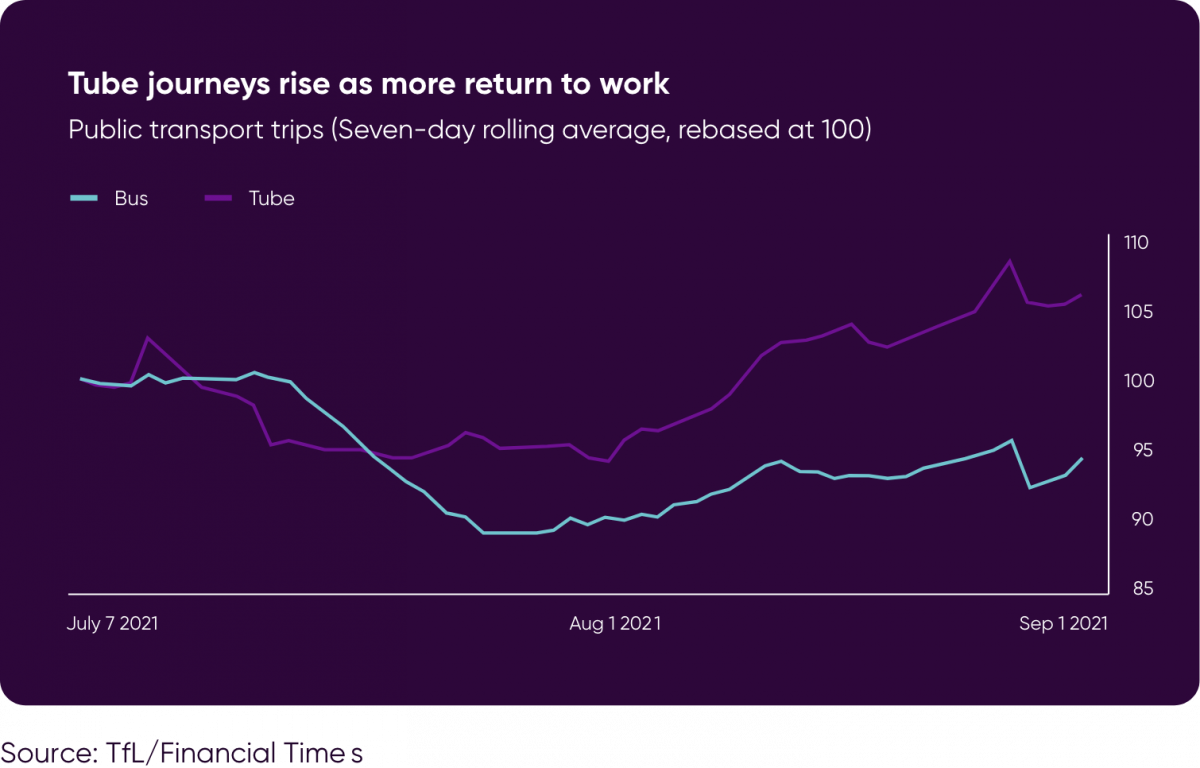
Data from the ONS’ Business Insights and Conditions Survey in April 2021 stated that 24% of businesses intended to use more home-working as part of their future business models.
A study conducted by the BBC in May, stated that nearly all of the UK’s 50 biggest employers did not plan to bring all staff back to the office full time. In September, it emerged that bosses across the City of London were hoping to entice their staff to spend at least some of the time at their offices by offering social events and free food.
But a poll by the Chartered Management Institute of more than 1,000 managers suggested that four out of five thought some staff would be asked to return to their offices for a minimum number of days’ attendance.
Ann Francke, chief executive of the Chartered Management Institute, told the Financial Times that while a “Big Bang” return to the workplace was unlikely, “the office is still viewed as an essential aspect of working life and a place to connect with colleagues, learn from each other, collaborate and socialise.”
Many private sector businesses have plumped for policies which state that staff must work from their office between two and four days per week. Some employers are leaving it more flexible but keeping policies under review.
For most organisations, however, the introduction of a new blended working environment requires yet a further shift in ways of working, and associated policies and practices. These come on top of those changes introduced as a result of the various lockdowns and movement restrictions imposed over the past 18 months.
Figure 4: There is a positive relationship between current remote working practices and future homeworking intentions
Current working arrangements and future remote working intentions, businesses not permanently stopped trading, weighted by employment broken down by industry, UK, 5 April to 2 May 2021
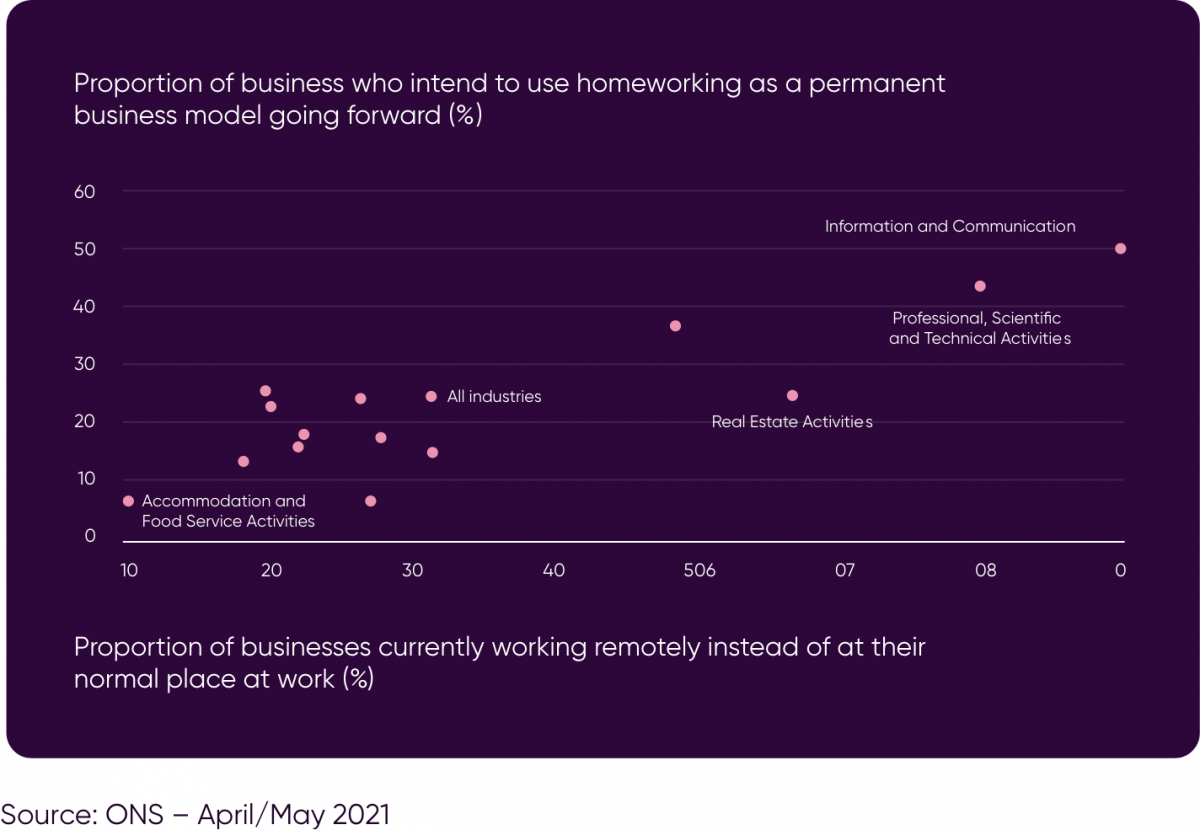
In part, the solution to the new ultra-flexi working environment will come from technology and the use of collaborative tools which are optimised to handle a mix of office-based and virtual teams.
Most organisations have adopted technology solutions such as Zoom, Avaya Spaces, Microsoft Teams, Slack and Google Meet to help bridge the gap between office and home. The aggregate amount of time people spend on the Teams platform, for instance, has tripled to 45 million hours a day since 2020.
Meanwhile, a Gartner Digital Worker Experience Survey of 10,800 full-time employees in the US, Europe and Asia-Pacific showed that nearly 80% of workers are using collaboration tools for work in 2021. This is a 44% increase since the pandemic began.
“As many organisations shift to a long-term hybrid workforce model, cloud-based, personal and team productivity technologies, along with collaboration tools, will form the core of a series of new work hubs that meet the requirements of various remote and hybrid workers”
Christopher Trueman, principalresearch analyst at Gartner.
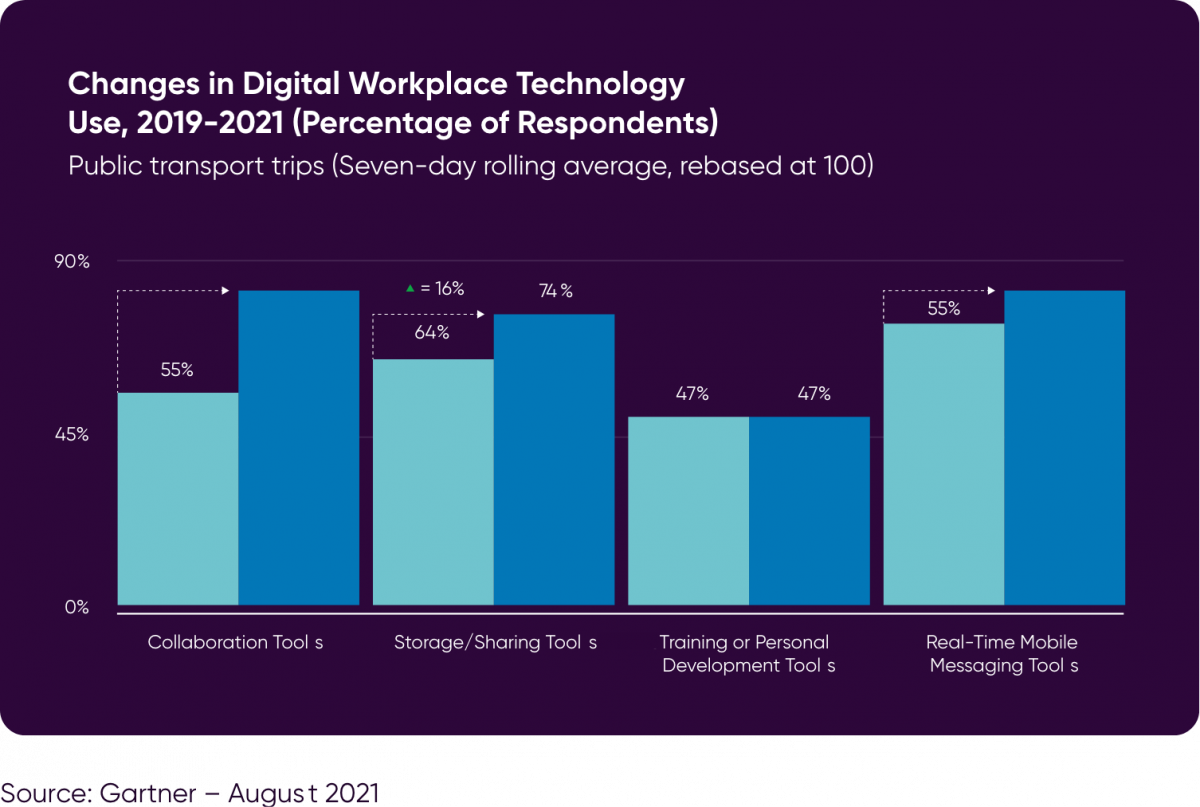
Can hybrid work in the public sector?
In August 2020, a bid to encourage UK civil servants back to their desks had to be aborted after COVID-19 infections started to rise. Unions representing nearly 500,000 public sector employees said the move had been unnecessary, given successful home-working by staff in government departments and local authorities up and down the country, throughout the pandemic.
A UK cabinet minister has suggested that civil servants should have their pay docked if they refused to return to the office – a claim criticised by the civil service union, the FDA. The government said that its approach, of gradually and cautiously increasing the number of staff working from their offices, takes advantage of the benefits of both office and home-based working.
A recent study conducted by the FDA found that 97% of its members wanted to continue with some form of home working after the pandemic. The most popular option (32%) among those favouring a flexible pattern were those wanting to work from home for 60% of the time, or three days a week for full-time employees. Twenty-six percent said they would like to work from home four out of five days, and 20% for two days a week. Just 9% said they wanted only one day a week at home.
Similarly, a report for the government on Home Working in the UK Civil Service, suggests that the vast majority of civil service employees view remote working more positively than before the pandemic, and that 73% would prefer to work remotely for at least three days per week.
Many public sector employees, ranging from Whitehall departments to those in town halls and contact centres, have successfully worked from home during the pandemic.
A report for the Government Property Agency suggests that public and private sector organisations alike must acknowledge that employees have a new benchmark for workplace experience”"their own homes”" and that these homes support some work activities better than offices.
The study also acknowledges that working from home suits some roles, departments and some individuals, better than others but overall the sentiment towards homeworking is warm among public sector employees.
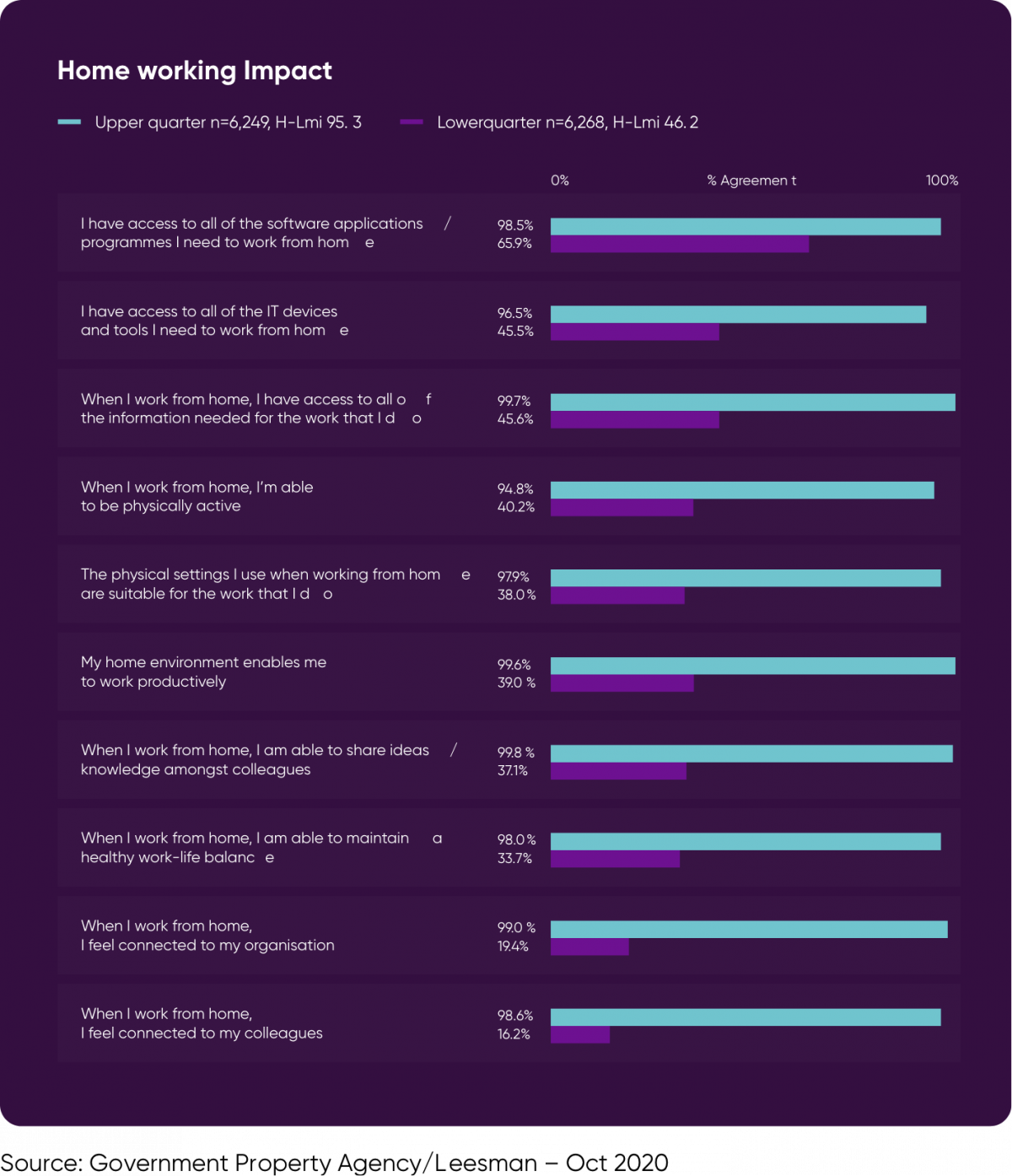
When the initial COVID-19 lockdown was introduced in March 2020, FourNet helped transition a large financial institution’s 4,000 employees to work from home, rather than from its headquarter offices. A 2021 survey of the institution’s staff showed that the majority hoped to continue working from home at least two days a week after the pandemic.
From September 2021, in a pilot scheme, the same organisation’s staff have been asked to work from the office a minimum of once a week for ‘team days’ as they feel that time and physical presence with teams remains important. The financial institution says it plans to encourage more flexible working, adapt its buildings, invest in new technology and engage with staff in new ways. Like many organisations, it is also considering its property footprint as a result of the new working environment.
With tens of thousands of public sector employees across the UK, a move to greater remote working could significantly reduce costs for taxpayers and council taxpayers alike.
In London in particular, there are suggestions that so-called “London-weighting” – which compensates workers for the higher cost of living in the capital – could be removed from those who work from home. Reduced office space could save taxpayers’ cash, while allowing workers in more remote, or less affluent areas of the country to take up employment and work more flexibly without lengthy commutes.
But for efficient and collaborative working, which also protects mental health and employee experience, organisations will require to invest in up to date technology and flexible workforce management and collaboration tools.
The virtual contact centre
Not surprisingly, since 2020, the demand for cloud-based virtual contact centres has rocketed – helping organisations keep their customers happy, and staff safe and socially distanced, during the pandemic.
The move to a more flexible, agile working environment can benefit agents and employers alike, and allows businesses to tap into a much wider pool of talent.
The 2021 Contact Centre People Engagement Survey, carried out by trade bodies, Call North West and South West Contact Centre Forum shows that relations between businesses and employees, and between teams, has fared well as a result of the shift to more flexible working.
Their survey suggested that 70% of agents and advisers who mainly worked in bricks and mortar contact centres prior to lockdown have now switched to working more from home. The majority, 88% of those individuals felt that the switch had gone well.
Working from home is expected to continue to play a significant role in the contact centre industry for the foreseeable future.
While 43% of agents and advisers believe they will be returning to the office 100%, significantly more (57%) according to the same survey, believe they will be home working, with the majority of those splitting their time between their home and the office.
Nearly two thirds of Directors and Managers (60%) say that they expect 50% or more employees to be working full or part time at home, with just 4% predicting a full return to the office.
With the appropriate workforce management tools, virtual contact centres can help to flatten the curve in call spikes, with much better handling of overflow calls. They can also be structured according to specialised virtual teams, which are easily reorganised without office moves. The cloud-based nature also allows for 24-hour contact cover.
Perhaps most importantly, for employees they have the potential to create a much better work life balance and, for employers enhanced employee engagement.
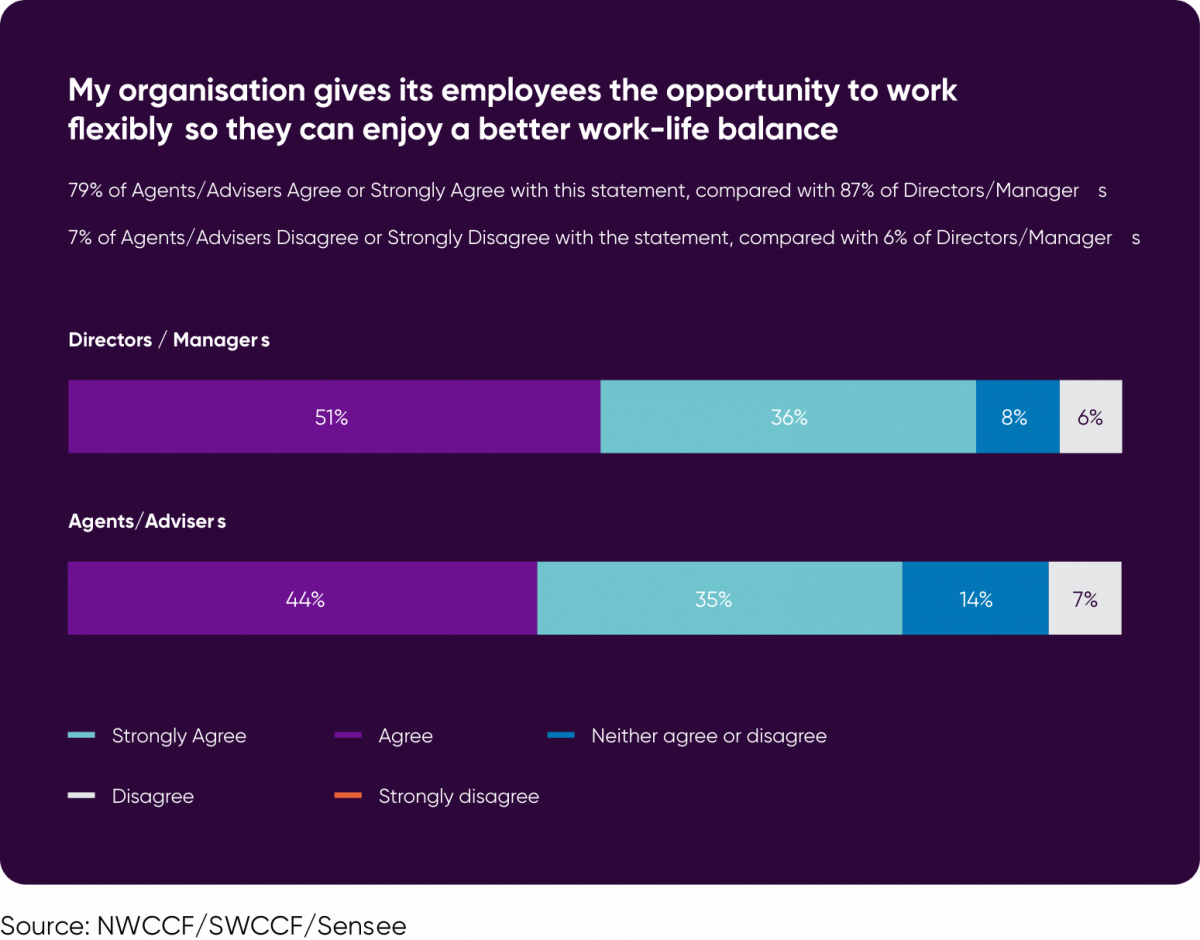
Hybrid - a better deal for diversity and inclusion
There’s never been a time in recent history where more people worked from home than worked from their place of employment.
The pandemic changed that, and our way of thinking about work.
Working remotely can improve work-life balance, reduce commuting time and costs, improve IT upskilling, encourage reduced absenteeism and higher levels of job satisfaction.
Studies have shown that women, in particular, show higher levels of job satisfaction when flexible working arrangements were offered – even if they didn’t take up that option. Younger workers also often prefer more flexible arrangements.
While flexible working arrangements (FWAs) have long been in existence, they’ve not been without challenges – for employees and employers alike.
While many workers have traditionally requested FWAs to enable them to balance family, parental and work roles, the focus on ensuring team cohesiveness and inclusivity has been much less of a management concern.
The pandemic changed that too.
According to research by the Chartered Institute of Personnel and Development, before the pandemic, 65% of employers either did not offer regular working from home at all or offered it to 10% or less of their workforce. After the crisis, that is expected to fall to 37%.
As a result of enforced home-working because of the pandemic, there’s been greater consideration given to employees working conditions at home, their mental health and creating virtual social events to keep up team spirit and morale, out of the office. This is likely to continue as human resources departments grapple with the new landscape.
But while COVID-19 has impacted certain groups more heavily than others, in relation to age, weight, sex, ethnicity, socio-economic background, disability or pre-existing health condition, it’s also created a virtual working environment which in some cases may enable those individuals to be able to continue in work, or even take up previously inaccessible jobs.
Hybrid working can help support inclusion and diversity in the virtual workplace, allowing individuals to consider roles which they might have been considered ill-suited because of childcare commitments, commuting time or distance, disability or illness.
Remote working provides employers with an opportunity to create a more diverse workforce, with staff from different geographies and backgrounds and across all job levels, functions and teams.
It can help to close the gender gap by offering greater flexibility and opportunities for women, including single mothers with children, and particularly in male dominated industries.
Working from home can make it easier for workers with special needs who might find accessibility within the workplace prohibitive. It can also help to eliminate visual biases within the workplace – assumptions made about individuals because of their visual appearance.
A remote opportunity for the planet
As the latest UN Climate Change conference (COP26) looms in Glasgow in November 2021, organisations and individuals are looking to their own environmental credentials.
There’s no doubt that remote working can be good for the planet through reduced domestic and international travel which will help to cut organisational and individual carbon emissions.
Transport accounts for around a quarter of global CO2 emissions, and the daily commute is a significant contributor to the UK’s carbon emissions.
A survey by online job site Monster shows that if the UK went down a similar route as the Netherlands, where as little as 47% of the population works in a traditional office, the number of workers commuting into London each day would reduce from nearly 4 million in 2018 to less than half that by 2025. In Greater Manchester, those commuting by train would drop from 1.3m per day in 2018 to around 650,000.
The same study suggests that there’d be nearly 380,000 fewer cars in London, 75,000 fewer in Leicester, and a similar drop in Birmingham by 2025 – with CO2 emissions plunging, as they are required to do if we are to live on a planet healthy for all.
Will working from home help the UK hit its climate change targets, by reducing the CO2 emissions of employees? It could certainly help.
According to the O2 Business 2020 Flexible Future of Work report, scrapping the daily commute would be popular among younger, environmentally conscious employees. 51% of Gen Z and 53% of Gen Y surveyed said they were concerned about the environmental impact of commuting. 39% of workers surveyed wanted to take fewer business trips to help protect the environment.
With many businesses now much more focused on sustainability and their Environmental and Social Governance policies, the pandemic has brought about a shift in thinking which could help, in part, to tackle climate change.
Reducing office capacity could help lower energy consumption for businesses, especially in the summer months when air conditioning systems are on full blast.
In addition, being more environmentally aware will help to attract employees and new talent.
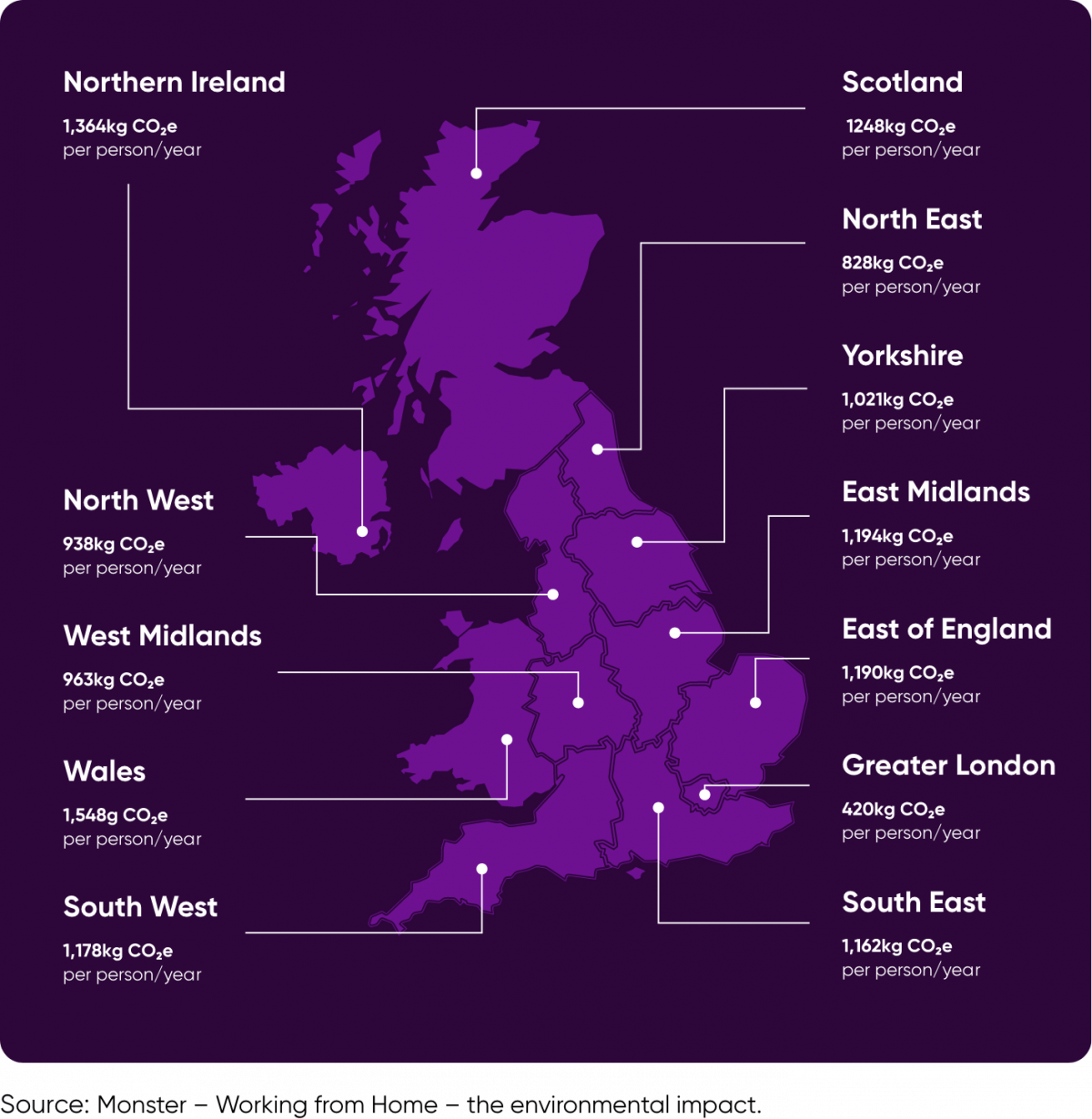
How FourNet can help
The COVID pandemic forced the majority of UK businesses into a state of remote work. But, as companies slowly return to the office, how should they adapt their systems and processes to survive in the new normal?
With office and remote workers battling for bandwidth and access to onsite systems, day-to-day operations will inevitably be slow. Investing in flexible cloud solutions that enable collaboration across locations, support your systems, store your workloads and have safety and security built in is essential.
FourNet can help our customers adapt to, and address the challenges of, this new hybrid environment with our portfolio of solutions and services.
FourNet’s expertise in transitioning our customers to the cloud extends to all layers of the tech stack. From networking and infrastructure through to the application layer, our expertise lies in making it all work together.
Here’s a taster of how we can help:
Unified Communications as a Service (UCaaS)
FourNet partners with both the Gartner Magic Quadrant stand-out leaders offering solutions based on both Microsoft and Ring Central, offering the full suite of communication and collaboration capabilities.
Teams Meeting Rooms
Create dynamic meeting room set-ups which offer collaborative experiences no matter where you are working. With Teams Meeting Rooms you can combine virtual and face to face meetings to create a rich, collaborative experience for everyone.
Analytics
FourNet incorporates additional analytic tools to properly log and monitor calls, even via Microsoft Teams, providing you with a detailed understanding of your Unified Communications usage - whether softphone, video, instant messages or desktop sharing. Monitor activity and present data: intuitive analytics enables you to access data the way you need it; gain insights into adoption, costs, billing, performance, capacity and usage.
Microsoft Teams Direct Routing
One direct dial number with full voice capability. Our fully integrated solution routes all calls into Teams so that employees can answer via PC, laptop or Teams app on a mobile. It delivers seamless call switching, no loss of telephony system functionality and cost savings, with no need for Microsoft calling plans or on-premise hardware.
Cloud contact centre capabilities
FourNet offers a full range of market-leading CCaaS solutions, with our Agile Cloud and Community Cloud platforms. From simple, easy to adopt contact centre solutions to highly resilient and complex customer experience platforms; FourNet has a solution for every customer's needs. Our platforms support and enable agents whether they are working from the office, remotely or a mix of the two.
AI for call deflection
Keep customers happy during periods of peak demand with artificial intelligence assistants or chatbots, powered by conversational AI, to shift incoming calls from human agents to digital channels.
PCI solutions for handling card payments while working from home
FourNet offers industry leading PCI solutions to deliver secure payment solutions for Cardholder Not Present payments. We integrate with the call flow and at the point of payment, intercept any tones as they are entered by the customer on their telephone keypad, meaning the agent doesn't hear or see the card data.
Employee Wellbeing
Workforce Management (WFM) & speech analytics tools can identify stressed or vulnerable employees, allowing targeted interventions to safeguard agent and employee wellbeing whether they are home or office based.
Workforce engagement tools
Help promote a better work life balance, permitting flexible scheduling, holiday allowance and self-service and AI applications which reduce the quantity of mundane and repetitive customer engagements and allow resource to be shifted to higher value activities.
Microsoft Teams Contact Centre integration
Our multi-channel contact centre capabilities provide customers access to your agents via their channel of choice - phone calls, voice messages, email, SMS, web chat, social media - in a single, fully integrated solution. The Microsoft Teams shared workspace then enables your agent to effortlessly engage back-office experts to provide the best resolution available for each customer contact.
Knowledge Management
Enabling consistent customer journeys by ensuring everyday questions are answered quickly and efficiently whether in self-service mode or via contact centre agents working remotely or on office premises.
Call recording
FourNet can provide call recording of all external calls into our Teams Direct Routing solutions. Calls are encrypted and the application is fully GDPR compliant. We can provide a range of call retention and archiving options. Resilience of call recording is provided by our dual data centres.
Quality management
Automated omnichannel quality management processes which provide a range of tools for managers, from scoring evaluations to assigning training. This enables you to shift resources from manual monitoring and management tasks to higher-value activities.
Gamification
Build team cohesiveness and boost motivation. These tools can help engage and incentivise employees to perform better based on key performance indicators. They also satisfiy core psychological and motivational requirements both for individual workers and teams.
Networking and Infrastructure
To compete in the digital world, businesses need constant access to their data and systems through applications that perform efficiently, 24/7. The shift to hybrid working can impact this.
With data and applications hosted in the office and accessed by users both on site and at home, connectivity becomes a bottleneck and can slow down your workforce. Hosting your systems and applications off-site and in the cloud can help protect your employees' time in getting and staying connected from anywhere, which in the long term will impact their workload and your business's bottom line.
Unreliable VPNs have made homeworking difficult for lots of UK businesses during the pandemic and have forced many employees to forgo office safety procedures - i.e. saving work on business systems behind cryptic email passwords - and saving their work on physical hardware instead.
When applications are hosted in the cloud, all users can access their business applications and data, easily - with no worries about struggling connectivity from dodgy bandwidths, lost intelligence from hackers or waiting for broken hardware to be fixed - it's all taken care of behind the scenes.
FourNet is expert in helping customer review, plan, implement and manage for this new network reality.
Inherently Secure
FourNet works with some of the most secure, critical and commercially driven organisations in the UK. With Security Checked (SC) & Developed Vetting (DV) cleared engineers as well as ISO27001 accreditation and Cyber Security Plus certification, FourNet is inherently secure. Our engineers are cleared to handle some of the UK's most secure communications.
Our solutions are hosted in Tier IV data centres with fully redundant subsystems (cooling, power, network links, storage etc) with compartmentalised security zones controlled by biometric access controls methods. Secure remote access is provided for service users with fully encrypted voice, video, email and IM using TLS and AES 256 SRTP protocols available over the internet.
Cybersecurity solutions - as employees have switched to working from multiple locations the attack surface of the network continues to expand. In addition, the last eighteen months has seen an increase in the volume and sophistication of cyber-attacks on companies across the world. FourNet works with industry leaders Fortinet to offer a full range of cyber-security solutions.
For effective security, organisations have to shift from protecting security perimeters to protecting data spread across the billions of edges, users, systems, devices and critical applications. Fortinet's platform provides comprehensive visibility and protection across devices, users, endpoint, cloud, SaaS, and infrastructure, covering the entire attack surface.
At the core of the platform security-driven networking provides secure high-performance connectivity between users, applications and devices into the cloud.
- Manage internal and external risk with internal segmentation, threat detection and automated threat protection and policy enforcement.
- Our zero trust access network enables identification of all users, applications and devices on and off the network.
- Our dynamic cloud security provides protection across all cloud environments including hybrid, public and private cloud.
- Our cloud security solutions, including virtual appliances and hosted solutions, extend the core capabilities of the Fortinet Security Fabric platform to provide businesses with the same level of cybersecurity and threat intelligence in and across cloud environments that they receive on their physical networks.
AI-driven security operations provide faster response and remediation including actionable, customised threat intelligence and insights.
All of this is managed by FourNet's security cleared engineers ensuring that customers have a single port of call across their whole infrastructure and application stack.
How we do it
As well as our extensive portfolio of services and solutions, we have teams with years of experience and expertise to bring to each and every project. FourNet has a customer retention rate of 99.97% and our latest independently conducted customer research gives us an NPS score of 82.
The whole FourNet team from initial engagement to service delivery is focused on the business objectives that our customers are trying to achieve.
Intelligent Managed Services
Digital transformation projects have increased the rate of technology adoption – but relevant skills and experience remain in short supply. This is where our Intelligent Managed Services can make all the difference. We work as an extension and support for your in-house team, freeing up their time and enabling you to adapt quickly to changing ways of working & increasing customer expectations. We can often reduce costs of technology support and offer longer and more flexible hours of service support.
At the heart of every FourNet Intelligent Managed Service package is our 24:7:365 service desk, our team of experienced engineers and our dedicated Service Delivery Managers. We provide proactive monitoring, problem management, service desk, back up, disaster recovery and more. All delivered to standard SLAs.
Highly experienced Project Management Office
New technology no longer needs to take months, if not years, to deploy. We can deliver rapid change to your business using our highly experienced, full time Project Management Office.
Our sector aligned teams are certified in Prince2 Practitioner, Agile Foundation and Association for Project Manager Professional and our approach is flexible; we can either take the lead and recommend what we think will work best for your project or align with your own preferred methodology.
As an example, we use Agile Project delivery for our approach to Agile Cloud Service Delivery and divide the project into a series of timeboxed sprints:
- Sprint 1 delivers a SIP service layer to a customer’s existing MS Teams via Direct Routing in 10 working Days.
- Sprint 2 delivers Contact Centre and Call Recording in 20 working Days. (Sprint 1 is a pre-requisite to Sprint 2).
Our dedicated PMO will help you define the Statement of Work (SoW) at the outset of the project covering ‘The Scope’ which will be delivered and against which ‘Change Control’ will be managed. We’ll also devise a Project Plan outlining the sprints and ensure that your project is managed professionally from the outset so you can rest assured that your project will be delivered on-time and on-budget.